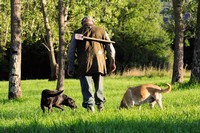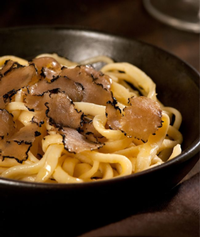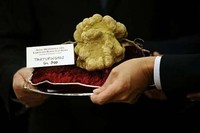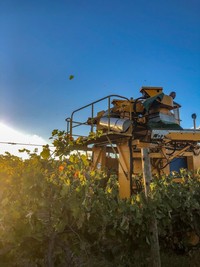Our Blog
White Gold. The White Truffles of Alba.
Readers of this blog may have experienced – and hopefully enjoyed – a dish or two at a di Lusso Estate Truffle Day. We can only serve the black Perigord truffle – the only available type of truffle outside of the Alba region Piedmont in Italy, le Marche in central Italy and a small slice of the Balkans where the famed white truffle is found – and the experience is pleasant enough, but I must say not a patch on the white truffle that Luanne and I have experienced several times in Alba.

< Truffle country in Piedmont
Ignoring the peasants who associate the truffle with ‘just like toe jam’ (as we called the smell of our locker room youth), and those who claim the smell is that of testosterone (lucky analysts, I guess) the white truffle aroma, produced by soil bacteria trapped inside truffle-fruiting bodies, is best described as intensely musky, with a buttery, garlicky, sweaty intensity.

But the white truffle’s ability to transform the taste of a simple poached egg, bowl of linguini or even just a piece of toast, is extraordinary.
At our usual Barbaresco hotel – the Locanda Rabaya – shaved white truffle is served every evening for four weeks in late September/ October– almost always with pasta washed down with Barbaresco wine from the village itself. Unforgettable!
Recently, we saw the much- heralded Italian documentary Truffle Hunters, which traces the last few years of a community of old hunters and their dogs. There was no commentary; just the real-life conversations between hunters, between these old men and their dogs, interspersed with shots of the very lucrative global food industry that has been built around the white truffle. Poignant and beautifully filmed…. But sad, very sad.
These octogenarians could just not understand how what was happening….what was once a pastime enjoyed by Piemontese in the rugged hills of our favourite part of Italy had changed so dramatically. (We recognised many of the scenes in the documentary from walks we had enjoyed along the banks of the Tanaro, which flows around the town of Barbaresco).

Nowadays, conversations were more likely to be about truffle dogs being poisoned by jealous and unscrupulous competitors, families being separated by greed, men being unable or unwilling to retire even at the age of ninety as they chase the ‘next and final giant truffle’, ways to unfairly manipulate the price of white truffle price in the market headquarters in Alba by subterfuge.
A scene from the documentary….an elderly hunter enjoying dinner with his best friend.
And then I came across an article purporting to ‘capture the commercial essence of the white truffle industry'. It came complete with industry projections of market size (generally smaller each year), forecast downstream demand, SWOT analyses, CAGR market growth estimates, scenario after scenario etc etc etc. I couldn’t help thinking it was a pity that our ‘global economy’ had devalued yet another noble and ancient craft.

PS. The price of white truffles is quite astounding…the bigger the truffle, the higher the price by weight. In a ‘normal’ market, a very large white truffle will sell for well over $10,000 a kilogram.
In 2010, a white truffle weighing less than two kilos sold for US330,000! Needless to say, scientists around the world – led by the French, of course – are trying to grow the white truffle in other parts of our planet. Without success, so far at least!
Our Nebbiolo has origins in the Piedmonte region and is an excellent match for Truffles, or indeed any Italian meal that features mushrooms (Porchini Fungi Risotto, anyone?).
Robert
Vintage Reflections
Hi Everyone,
End of the vintage leads one to reflect on the wine of the current and previous seasons. Thinking about winemaking, here’s a little secret …. the best wines make themselves. Yes… that’s right… an excellent wine is one where a winemaker does just the “standard winemaking,” and the result is fantastic. “Great vintages begin in the vineyard”, it’s excellent fruit that makes winemaking easy.
 For example, the 2018 vintage was very easy… A long summer, followed by a warm, dry autumn resulted in excellent fruit across the vineyard. And if you’re a lover of Mudgee wines, you’ll be happy to know that the whole region experienced above average levels of quality… but at the cost of a significant drop in yield (which is generally a good thing!). Our favourites wines that year were the Lagrein and the Arneis 2019 was undoubtedly a season of drought, with a dry summer following a dry winter. We took advantage of our very good irrigation setup to replicate a ‘normal’ European winter with weekly waterings through winter, so that during the hot summer the vineyard’s resistance to drought both below ground and in the canopy was higher. Like its predecessor, the 2019 outcome was high fruit quality but with a bigger crop.
For example, the 2018 vintage was very easy… A long summer, followed by a warm, dry autumn resulted in excellent fruit across the vineyard. And if you’re a lover of Mudgee wines, you’ll be happy to know that the whole region experienced above average levels of quality… but at the cost of a significant drop in yield (which is generally a good thing!). Our favourites wines that year were the Lagrein and the Arneis 2019 was undoubtedly a season of drought, with a dry summer following a dry winter. We took advantage of our very good irrigation setup to replicate a ‘normal’ European winter with weekly waterings through winter, so that during the hot summer the vineyard’s resistance to drought both below ground and in the canopy was higher. Like its predecessor, the 2019 outcome was high fruit quality but with a bigger crop.
Of the 2019 wines, at this stage (bearing in mind not all have been bottled), I particularly like the Sangiovese and the Barbera (including our first ever sparkling Barbera which we call Vivace! The 2019 Nebbiolo sits closely behind. Then along came the 2020 vintage. Were we tested? Yes! Firstly, the third year of drought brought a quite small and inconsistent – and late – flowering and fruit set. So late was fruit-set that the fires that began seriously in September and which brought a pall of smoke that hung over New South Wales for some months from October caused few problems for us. (But the same could not be said for many other growers, particularly those to the east of the town; or for unirrigated organic growers, whose fruit tends to flower earlier). Despite more sampling and tasting than ever before, we could find no fault in either the Arneis or the Vermentino were excellent. Then, a few weeks later, our early-picked Sangiovese (for Vino Rosato) checked out really well.
The 2020 reds required very careful handling. We were very away of the risks attached to ‘standard’ practices of ours. Maceration (that is, the soaking of skins during and after fermentation), oak maturation (we initially only used stainless steel for malolactic fermentation), and very frequent panel-tasting of the red wines before bottling. (None have been bottled yet). So far so good! We’ve not detected any smoke-taint so far in any of our own wines, but continue to be watchful. So, what’s my favourite wine from 2020? At this early stage, I would say the Vino Rosato, followed by Vermentino and Arneis. I’ll reserve my judgement on the reds until just before bottling, but my hopes are high.
Finally, talking about bottling. I aim to have our 2020 Vino Rosato released in June (“due to popular demand”), with the 2020 Vivo! sparkling next – in August. And remember, if you have any questions about the wines, please call or email me. I always look forward to a conversation with wine club members.
Regards
Rob Fairall